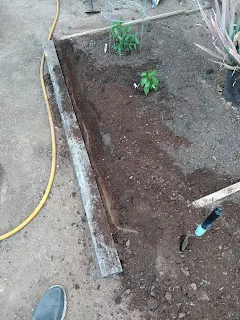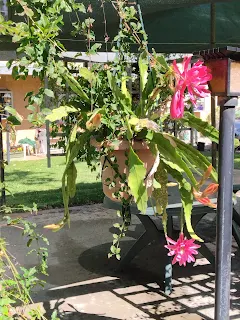I finally figured out the technical difficulty preventing me from uploading photos from my ipad to dropbox. Easy peasy from my android phone but just could not figure it out from my pad. Got it done though so now I have pictures! So it seems there's still an issue between getting the photos on dropbox and being able to load them here. Apparently blogger doesn't like to load from dropbox even though it's an option. Today is a technical difficulty day it seems. Even when they're on my desktop I get an error for it to load. No reason, just an error, try again.
Anmyway, I bought a small Better Boy tomato and a Jalapeno plant at the small nursery half a block up the road from me. Walking distance so I get some exercise too.They didn't have much of a selection for tomatoes and I almost bought a Sweet 100 tomato but I didn't feel like creating a huge structure just for it. Yes they get that big.
Here's the basics about tomatoes for those not initiated or experienced:
Always plan on using a cage bigger than you think you'll need. Tomatoes come in two (possibly three) categories now. Determinate, indeterminate and patio which fall into the determinate category but are dwarf. Determinate is just what it alludes to, it grows to a determined height, flowers, fruits then as that is happening it starts yellowing and dying from the bottom up and finally poops out entirely. This could take a matter of a few months depending on the variety and the time of year. Generally they average about five to six feet. Indeterminate means as it grow it flowers and fruits continuously and could very well reach seven to eight feet tall before it finally gives up the ghost or the weather works against it. This is a best case scenario of course. Worst case a determinate can get four feet and their done. Just as with people and pets, the better care they get the longer and healthier life they have.
Yes you feed them during the growing season. You want to know how many people didn't want to feed their fruiting and flowering plants because they were doing just that? Rediculous! 'Oh I didn't want to spoil the fruit with too much fertilizer'. I'm telling you.... also 'oh I didn't know my plants needed fertilizer (food)'. You going to take a puppy home and only give it water?
So anyway, on some tomato plant tags or signs it will have a description of the fruit but also look for those words 'determinate' and 'indeterminate'. Now 'Patio' tomatoes are quite literally called that, they are one of a kind. They usually get about two feet maybe taller and produce medium to small fruit, not a cherry tomato but bigger than that. I'm no good at measuring according to weight but they'll fit in the palm of your hand neatly.
Now I figured out how to get pictures on here again so here goes:
You see that divot? That's as far as my hoe could dent the soil. It hadn't been watered since it rained months ago. Native dirt with no additional amendments. Those twigs and leaves don't count.
This is after I watered thoroughly. You can see the puddle where I had previously tried to dig with the hoe.
This is the soil color difference the next day. The smaller darker pile is from my worked bed with amendments. The lighter crumbly one is moist native dirt. In vernacular as far as I go is 'dirt' is what is in the ground, 'soil' is what you get in a bag or after you've corrected the dirt with amendments.
This is after the soil dried two days. I was able to dig the hoe in and actually loosen the soil. Not as easy as my bed but easier than it was two days previous. I will keep it loosened but considering how much amendment I need, I won't be able to move it from the car to the garden by myself. It will have to lay fallow for a while yet. But also shows it has pretty good drainage on it's own.
This is the six inch trowel I found. I'm prepping the hole to put the tomato in. I hadn't watered it yesterday so I got the hose and watered that corner well since the veggie rootball was very wet I didn't want to drop it in dry soil. You can also see how the shadow of the building is starting to creep in. It was about 1:30 which is perfect timing for planting. It gets full shade by 3 so the plants won't be trying to adjust to blazing heat in the middle of the day.
And there they are, all snug in their bed. About 18 inches apart, likely too close but I didn't water the whole bed and had turned the water off already. The soil was plenty moist so i wasn't worried.
Now, you know what's missing? Fertilizer. I looked at the selection at my tiny family operated nursery and they had bunches of organic stuff in quantities and price I didn't want so fertilizer will have to wait. I can get a small packet of organic veggie food at ::cringe:: the orange apron store and is the perfect size for what I need.
See what I mean about the tomato cage? People don't think they need one right away but by the time you need one, it's too big to put a cage around it. Do it right away! One thing I forgot to get was a sprayer for the end of the hose. I could get a watering can but honestly, for not much more I'm getting a pistol sprayer and all done.
So, there you have it. Another secret about tomatoes and other thin leaf plants. Something that is called '3 o'clock wilt'. Are they dying? Nope, they're tired and hot is all. If you go out to your garden and see that the tomatoes are wilting and you know you just watered that morning, PUT THE HOSE DOWN AND STEP BACK!
Science: Plants have a vascular system that pulls nutrients and water up through their roots and to the leaves. That pressure system is temperature based as well as hydraulic driven. So if the plant is too hot their leaves have to shut down to prevent anymore moisture from evaporating than possible. So they wilt. (Leaves drooping, lack of water/too hot, leaves closing like a taco, too much water. TYPICALLY) There are other factors of course. It's a protective mechanism and just let them do their thing, check the soil with your fingers, if it's warm and moist, walk away. Check back when it's cooler or in the morning and they'll be right as rain. Aha... see what I did there? hehehehe.
So, Plants are in, I did talk to one of the landscape guys and asked about a piece of wood. He said there might be a couple of boards over in the storage area I could use. I didn't bother waiting but it'll all be good. Couple of sticks to mark the boundary and I'm good, in the future if I'm still here working on it, I can upgrade.
All done, all pretty.

















































